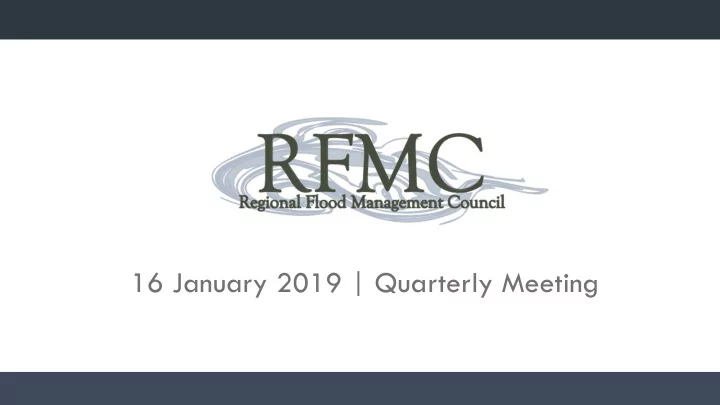

16 January 2019 | Quarterly Meeting
Flood Policy Survey Highlights January 2019 | RFMC Quarterly Meeting
Survey Overview Purpose: to determine detention requirements and all potential flood policy throughout the region Objective: To further understand all current flood policy throughout the region
Key Takeaways ▪ Need for…. ▪ Cross-jurisdictional studies and cooperation ▪ Improved mapping ▪ Comprehensive and uniform detention and floodplain regulations ▪ Lack of…. ▪ Compliance with current regulations and plans ▪ Power to enforce current regulations and plans ▪ Staff capacity
County Survey Highlights
Current Plans and Policies 100% 92% 54% 38% 23% 23% Floodplain LID Subdivision No Fill Floodplain Commercial Management Manual Regulations Requirements Regulations Regulations Plan
Current Floodplain Regulations In the 100- Year Floodplain …. 35 % of Counties have… 54% of Counties 11 % of Counties Greater than a foot have… or above BFE have … A foot or above BFE requirement…. At or above BFE requirement …. requirement…. 18 – 24’’ Above 12’’ Above At BFE
Current Detention Requirements ▪ Rates vary depending on a variety of factors: ▪ Impervious surface vs. development size ▪ Adjacency to floodplain ▪ Outfall ▪ 46% counties require specific criteria to calculate detention ▪ 54% counties do not require specific criteria to calculate detention
City Survey Highlights
Current Plans and Policies in Large Cities 100% 94% 88% 56% 56% 56% Storm Water Subdivision Floodplain Commercial Floodplain No Fill Management Regulations Regulations Regulations Management Requirements Plan Plan
Larger Cities ▪ 64 % had at least a foot or above requirement in the 100-year floodplain ▪ Detention requirements vary ▪ Detention rates vary from .2 to .75 acre feet per acre
Smaller Cities Cities 25,000 and Below: ▪ Need for increased awareness of flooding issues and the permitting processes Cities 10,000 and Below: ▪ Limited capacity to either set or enforce flood policies in their communities ▪ Refer to the county or drainage district for detention requirements
Recommendations for Consideration
Key Takeaways ▪ Need for…. ▪ Cross-jurisdictional studies and cooperation ▪ Improved mapping ▪ Comprehensive and uniform detention and floodplain regulations ▪ Lack of…. ▪ Compliance with current regulations and plans ▪ Ability to enforce current regulations and plans ▪ Staff capacity
Recommended Regulations Adopting No Fill Requirement No development or other encroachment, including fill, be allowed in a floodway which will result in any increase in the base flood elevations within the floodway during discharge of water of a base flood. No fill may be used to elevate structures in the 100-year floodplain.
Recommended Regulations Raising the Base Flood Elevation Requirement ▪ 24 inches above BFE in the 1% and .2% floodplain ▪ 36 inches or more above the depth number identified in the FIRM in all AO/ AH Zones and floodways
Recommendations for Implementations Develop uniform drainage criteria manuals for all counties and cities throughout the region
Recommendations for Implementation Provide technical assistance to county and city staff officials related to NFIP , grant procurement and administration
Recommendations for Implementation Conduct a building and construction industry-specific outreach campaign on required development regulations and procedures
Recommendations for Implementation Work with state advocacy organizations to promote stronger county/flood control district enforcement powers for floodplain regulations
Recommended Planning Support the development of regional flood planning efforts ▪ Identify sources of funding for future flood control and drainage planning ▪ Consolidate information from flood control planning efforts in the region and distribute to CFMs in the region
Questions
16 January 2019 | Quarterly Meeting
Resilience after Harvey Flood Mitigation Policy and Practice Kyle Shelton Director of Strategic Partnerships Kinder Institute for Urban Research
Key Lessons • Put people first. Ensure access to solutions. • Provide accurate public information and transparency. • Implement policies that prepare, not just respond. • We can’t stop flooding. Have to find ways to live with water. • Flooding amplifies other vulnerabilities.
Put people first. Ensure access to solutions. • Reevaluate cost-benefit rule for repairs. • Make sure there are projects in every watershed and that we are creating equal level of protection. • Enable low-income families to have options. • Consider ways to protect existing residents before making decisions about future residents.
Provide accurate public information and transparency • Use risk maps that take into account all types of flooding and work for folks inside and outside the floodplain. • Analyze the flooding issues of every watershed. • Create rules for disclaimers and public notice. • Empower communities to participate in decisions.
Implement policies that prepare, not just respond • Local funds provide flexibility for buyouts. • Remove people from harm’s way and regulate vulnerable land. • Flood warning systems. • Neighborhood recovery centers.
We can’t stop flooding. Have to find ways to live with water. • Green and gray infrastructure mixture. • Design solutions. • Land-use planning. • Addressing grandfathered homes.
Flooding amplifies other vulnerabilities. • Loss of car. • Loss of wages. • Health impacts. • Student mobility. • Addressing flooding is a way to address broader resilience goals and issues.
Recommend
More recommend